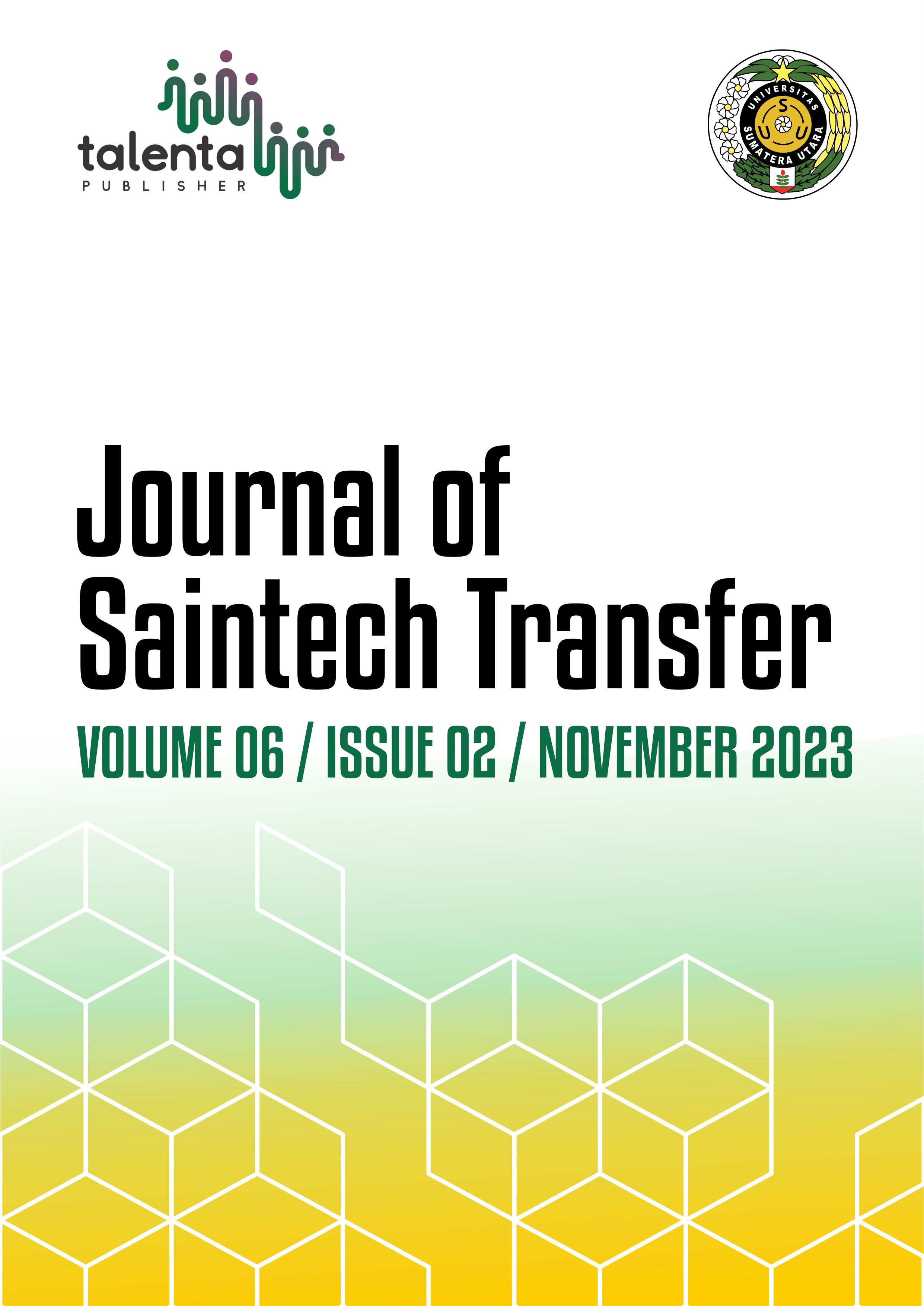Assistance for Oyster Mushroom Entrepreneurs in Making Fish Feed Formulations for African Night Crawler Worm (ANC) and Trichoderma sp. Fermented Bran
DOI:
https://doi.org/10.32734/jst.v6i2.10223Abstract
Utilization of baglog waste as a growth medium for ANC worms as a raw material for making formulated fish feed provides opportunities as a side business for oyster mushroom entrepreneurs to increase income. The purpose of this service is to provide assistance to target partners, in this case oyster mushroom entrepreneurs, in utilizing ANC worm flour as a substitute for fish meal and then formulated with Trichoderma sp. fermented bran. The results of the dedication that has been carried out show that there has been an increase in partners' skills in making formulated fish fefazidah@usu.ac.ided and developing the potential of science and technology-based independent entrepreneurs who develop from mushroom businesses. After this dedication, it is hoped that the partners can continue to develop this worm farming business and the application of worm-formulated feed for fish farming which has also been developed by partners so as to create an integrated oyster mushroom-based farming center.
Downloads
References
I. R. Dini, Hapsoh, R. Saputra, D. Salbiah, and S. Yoseva. "Development of integrated organic agricultural agribusiness at D jamuran Pekanbaru student business". ABDIMAS: Jurnal Pengabdian Masyarakat. vol. 4. pp. 966-972. 2021.
Sunarjo and S. Yuniarti. “Pemanfaatan sayur buangan untuk pakan cacing African Night Crawler (ANC) sebagai bahan pembuat peletâ€. [Utilization of discarded vegetables for feed for African Night Crawler worms (ANC) as a pellet making ingredient]. J Abdimas vol. 2. pp. 43-49. 2017.
Pangestika, D. S. Nurwidodo, and L. Chamisjatin. “Pengaruh pemberian pakan limbah baglog jamur tiram putih (Pleurotus ostreatus) dan kotoran ayam terhadap pertumbuhan dan produksi kokoon cacong tanah (Lumbricus rubellus) sebegai sumber belajar biologiâ€. [The effect of feeding baglog waste of white oyster mushroom (Pleurotus ostreatus) and chicken manure on the growth and production of ground cocoon cacong (Lumbricus rubellus) as a source of learning biology] Jurnal Pendidikan Biologi Indonesia. vol. 2. pp. 168-179. 2016.
S. Yuniarti, S. Sunarjo, and L. Sedyowati. "Budidaya cacing Lumbricus rubellus dengan media limbah jamur sebagai bahan dasar kosmetik dan obat-obatan". [Cultivation of Lumbricus rubellus worm with mushroom waste media as the basic ingredients of cosmetics and medicines]. Abdimas: Jurnal Pengabdian Masyarakat Universitas Merdeka Malang. vol 5. pp. 93-104. 2020.
A. T. Sutanhaji, L.D. Susanawati, and Lisnayati. “Komposting limbah baglog jamur tiram oleh cacing tanah (Lumbricus rubellus)â€. [Oyster mushroom baglog waste composting by earthworms (Lumbricus rubellus)]. Jurnal Sumberdaya Alam dan Lingkungan. vol. 6. pp. 12-16. 2019.
N. M. Ernawati, I. W. Arthana, G. R. A. Kartika, P. G. S. Julyantoro, and A. P. W. K. Dewi. "Praktik cara budidaya cacing Lumbricus rubellus dalam menunjang budidaya ikan lele di Desa Keramas Kabupaten Gianyar". [The practice of cultivating Lumbricus rubellus worms in supporting catfish cultivation in Keramas Village, Gianyar Regency]. Buletin Udayana Mengabdi. vol. 18 pp. 165-169. 2019.
A. Aziz “Budidaya Cacing Tanah Unggul ala Adam Cacingâ€. [Excellent Earthworm Cultivation by Adam Worm]. Jakarta: AgroMedia Pustaka. 2015.
Wirosoedarmo, Ruslan, S. E. Santoso, and F. Anugroho. "Pengaruh pemberian media berbahan limbah kotoran sapi dan blotong tebu terhadap bobot dan kadar protein cacing African Night Crawler (Eudrilus eugenia)". [Effect of administration of media made from cow manure and sugar cane granules on weight and protein content of African Night Crawler worms (Eudrilus eugenia)] Jurnal Sumberdaya Alam dan Lingkungan vol. 6. pp. 33-40. 2019.
Masjudi, H. H. Alawi, U. M. Tang, Rusliadi, A. Yuliandra. Effect of probiotic dosage on growth and survival rate of tapah, stripped Wallago leeri reared in laboratory conditions. International Journal of Oceans and Oceanography. vol. 14. pp. 221-230. 2020.
R. Saputra, F. Puspita, A. Hamzah, and E. Suryani. "Morphological characterization of Trichoderma spp. isolated from the oil palm rhizosphere in peat soils and its potential as a biological control for Ganoderma sp. in vitro". Jurnal Ilmiah Pertanian. vol. 19. pp. 56-68. 2022.
Hapsoh, Wawan and I. R. Dini. “Aplikasi Pupuk Organik dengan Teknologi Mikrob Mendukung Pertanian Terpadu Berkelanjutan Berbasis Tanaman Pangan pada Lahan Gambutâ€. [Organic Fertilizer Application with Microbial Technology Supports Sustainable Integrated Agriculture Based on Food Crops in Peatlands]. Laporan Akhir Tahun Hibah Kompetensi LPPM Universitas Riau. Pekanbaru. 2016.
S. F. Lestari, S. Yuniarti, and Z. Abidin “Pengaruh formulasi pakan berbahan baku tepung ikan, tepung jagung, dedak halus dan ampas tahu terhadap pertumbuhan Ikan Nila (Oreochromis sp)â€. [Effect of feed formulations made from fish meal, corn flour, fine bran and tofu dregs on the growth of Tilapia (Oreochromis sp.)]. Jurnal Kelautan: Indonesian Journal of Marine Science and Technology. vol. 6. pp. 36-46. 2013.
S. Fatimah, U. Santoso, Y. Fenita, and K. Kususiyah. “Pengaruh penggunaan tempe dedak dan tape dedak terhadap performa ayam broilerâ€. [Effect of using tempe bran and tape bran on broiler chicken performance]. Jurnal Sain Peternakan Indonesia. vol. 15. pp. 124-131. 2020.
W. Widayat, Y. Nasir, and A. I. A. Asfar. “Pengaruh konsentrasi ragi pada pembuatan inositol dari lamtoro gung dengan proses fermentasiâ€. [Effect of yeast concentration on the manufacture of inositol from lamtoro gung by fermentation process]. Indonesia Journal of Halal. vol 4. pp. 24-31. 2021.
Sitohang, V. Richardson, T. Herawati, and W. Lili. "Pengaruh pemberian dedak padi hasil fermentasi ragi (Saccharomyces cerevisiae) terhadap pertumbuhan biomassa Daphnia sp.". [The effect of giving rice bran fermented yeast (Saccharomyces cerevisiae) on the growth of Daphnia sp. biomass]. Jurnal Perikanan Kelautan. vol. 3. pp. 65-72. 2012.
Downloads
Published
How to Cite
Issue
Section
License
Copyright (c) 2023 Journal of Saintech Transfer

This work is licensed under a Creative Commons Attribution-ShareAlike 4.0 International License.















